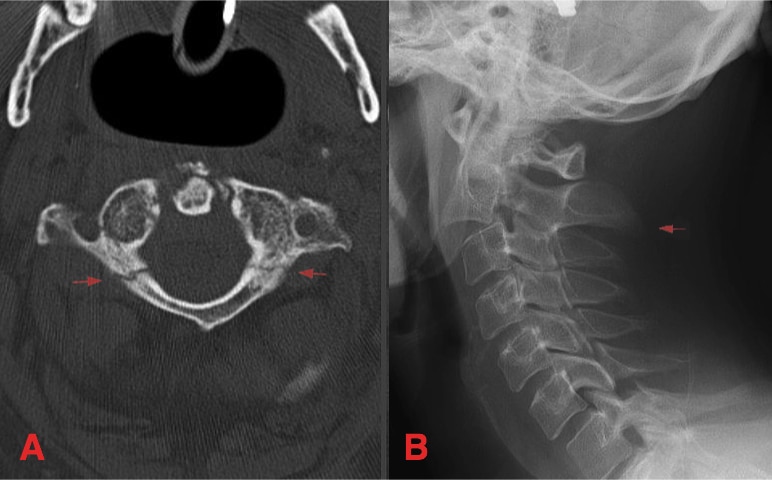Introduction
The cervical spine acts to support the head and provide mobility. However, it is susceptible to injury as a result, alongside having relatively small vertebral bodies.
The vertebrae of the cervical spine are frequently fractured; C2 (~30%) and C7 (~20%) are the most commonly fractured vertebrae. Due to the differing shape of C1 and C2, relative to the other cervical vertebrae, they present with unique fracture patterns that vary significantly compared to conventional cervical fractures.
Classification
There are many classification systems to describe fractures of the cervical spine, however the AO classification is most universally used.
For upper cervical fractures (involving the C1 or C2 vertebrae), the AO system divides them into:
- Region(s) involved:
- Type 1 = occipital condyle and craniocervical junction
- Type 2 = C1 ring and C1/2 joint
- Type 3 = C2 and C2/3 joint (Fig. 1A)
- Injury type:
- Type A = bony injury only
- Type B = tension band injuries
- Type C = translation injuries.
For subaxial fractures, the AO system divides them into:
- Injury type:
- Type A = compression injuries (Fig. 1B)
- Type B = distraction injuries
- Type C = translation injuries (Fig. 3)
- Type F = facet joint injury

Figure 1 – CT scan showing (A) fracture at the base of the dens (B) fracture of the C3 vertebral body
Clinical Features
Among younger patients, cervical fractures are usually the result of high-energy trauma, whilst older patients can develop cervical fractures from low impact injuries, especially if underlying osteoporosis is present.
Patients can present with neck pain, but this is not always the case, especially if there are concurrent (i.e. distracting) injuries.
There may be varying degrees of neurological involvement present, depending on the level of spinal cord involvement (further discussed here). Alongside potential sensory and motor deficits, innervation to the diaphragm and vasomotor tone can also be affected.
Any injury to the vertebral artery from a cervical fracture (especially in high cervical fractures) may present with a posterior circulation stroke.
Differential Diagnosis
Differentials for patients presenting with cervical neck pain, with or without neurology, following injury include cervical spondylosis, cervical dislocation, or whiplash injury.
Eponymous Fractures
Jefferson Fracture
A Jefferson fracture is the eponymous name given to a burst fracture of the atlas (Fig. 2A). It is caused by axial loading of the cervical spine resulting in the occipital condyles being driven into the lateral masses of C1. They are often associated with head injuries and other concurrent cervical spinal injuries. These fractures are usually unstable and account for approximately a third of all C1 fractures.
Hangman’s Fracture
A Hangman’s fracture, also termed as traumatic spondylolisthesis of the axis, describes a fracture through the pars interarticularis of C2 bilaterally (Fig. 2B), usually with subluxation of the C2 vertebra on C3. These are caused by cervical hyperextension and distraction (historically the forces that were delivered by a noose). These fractures can be unstable; in such cases, surgical fixation will be required.
Odontoid Peg Fractures
Odontoid peg fractures are common cervical fractures, most common in older patients. Patients can present following low-impact injuries, neck pain being common. The condition can be fatal, especially with significant displacement of the odontoid; those who survive can have no neurology.
Investigations
Any suspected cervical spine injury needs imaging, and the Canadian C-Spine Rules (further discussed here) can help in the assessment.
NICE guidelines will suggest for suspected cervical spinal fractures:
- Perform a CT scan in adults, if suggested by Canadian C-spine rules
- Perform MRI for children, if suggested by Canadian C-spine rules
Only consider a plain film radiograph in children for those who do not fulfil the criteria for MRI but where clinical suspicion remains after repeated clinical assessment.
Whilst CT imaging has become the mainstay for cervical fracture diagnosis, MRI is also useful to assess for concurrent injury of soft tissue structures, such as the intervertebral discs, spinal cord, nerve roots and posterior ligaments.
Management
Patients with a suspected cervical fracture must be managed as per ATLS guideline, including 3-point C-spine immobilisation, until any potential injuries have been excluded.
Restricting movement of the spine is recommended to prevent potential damage to the spinal cord; movement at the level of an unstable fracture can cause further neurological deficit*. All cervical fractures need discussion with spinal specialists.
Non-operative management can be appropriate for stable injuries (or may be needed for patients in whom surgical intervention is high risk):
- Rigid collars are used for immobilisation of the cervical spine during extrication and initial assessment
- Halo vests are used when more rigid support is needed, and are favoured for the non-operative treatment of unstable cervical spine fractures
- Pins are placed in the outer table of the skull under local anaesthesia, and are connected to a halo device, which is mounted on a thoracic brace.
Traction devices can be used for definitive treatment when operative treatment is high risk or fraction reduction is required (e.g. facet joint dislocation).
*If a spinal injury is identified, a further detailed examination is required; the American Spinal Injury Association (ASIA) chart allows an accurate and reproducible examination to be performed
Operative Management
Unstable fractures are usually treated operatively by fusing across the injured segment of the spine to the uninjured segments above and below, with or without decompression of the vertebral canal.
Stabilisation is most commonly performed via a posterior approach with the patient lying prone, the fragments then fixated using pedicle screws and rods.
Key Points
- The vertebrae of the cervical spine are frequently fractured
- Patients can present with neck pain or neurological impairment
- Any suspected cervical spine injury in an adult needs CT imaging
- Unstable fractures are usually treated operatively


